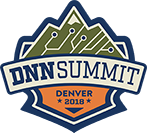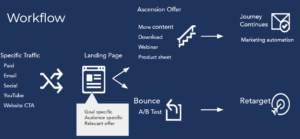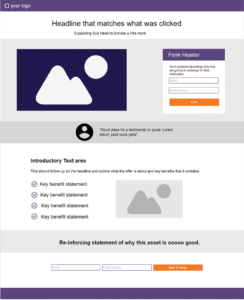The Risdall digital team attended DNN Summit, the largest DotNetNuke conference in the United States. The conference offered sessions on the direction of the DNN platform, modern development practices, current themes in digital marketing and practical advice for running DNN websites across multiple verticals. Keynotes were delivered by Andy Tryba, the new CEO of DNN Software, and Shawn Walker, the creator of DNN.

Risdall team member Erik Hinds led a comprehensive session on creating high-converting landing pages in DNN. Erik addressed all aspects of landing page creation:
-
- Definition & goals
- Creating a workflow
- Audience definition
- Crafting an offer
- Tools for effectively building a page
- Best practices for landing page design
- Conversion Rate Optimization (CRO)
- How to build landing pages in DNN
The bulk of the session focused on planning a proper conversion campaign by addressing the prospect’s needs, challenges, pain points and questions. Erik offered several strategies and tools to help identify those points and how your offer can help. Some of the tactics included:
- Creating customer personas
- Using a “Before and After” grid
- Outlining your touch points with a customer journey map
- Marketing automation
As Erik said, “Landing pages are merely a conduit for creating multiple touch points in a marketing program. The effectiveness of the landing page is contingent on creating a very specific offer and presenting it to a segmented and qualified audience. Speaking in a transformational manner and presenting your solution in the right sequential order is much more effective than directing high volumes of traffic at a web page and hoping for the best.”
Best Practices for Building Landing Pages in DNN
A fair amount of time was dedicated to covering best practices when designing and developing a DNN landing page. These best practices are universal across CMS platforms and addressed four key areas:
- Offer – is the offer clear, relevant and maintains “ad scent”?
- Form – are you asking for the right information, lowering form friction and building strong CTA’s?
- Building trust – are you using strategies for positioning your offer as trustworthy with testimonials and other forms of social proof?
- Visualization – have you ensured the page is laid out correctly, has visual appeal and doesn’t contain exit paths?
Testing CRO in DNN Landing Pages
Building a landing page is only the beginning of a successful landing page campaign. Erik discussed how to conduct optimization testing and some of the tools that can be leveraged.
As Erik noted, “Collecting quantitative and qualitative data is crucial to making smart decisions when determining whether the page is successful. There are a multitude of third party tools that can be easily integrated into DNN.”
Some of the types of testing and analysis Erik recommends are:
- Heat mapping / click testing
- Session recording
- Form drop off analysis
- Exit polls
- Preference testing
- 5 second testing
Erik finished up the presentation with an engaging Q&A session with audience members on some of the challenges they have faced when creating landing pages in DNN.
“It was a really great audience consisting of marketers and developers across multiple verticals. I loved how they engaged with thoughtful questions. I hope they received a lot of value from the presentation and Q&A.”
It’s easy to get caught up in the daily to-do list of emails, social posts, meetings and even remembering to eat. During this frenzy, have you taken time to really get to know the people you’re communicating with?
Our experience in marketing communications has taught us a few simple things that can help you develop a solid strategy and make it easy to implement. Your communications will be much more effective if you invest the time upfront.
These include:
- Identifying your audience(s)
- Building audience personas
- Reaching your audience exactly where they are
You Don’t Have A Communications Strategy If You Don’t Know Who It Is You’re Talking To
The statement above may seem obvious, but defining your audience and tailoring your communications so it’s relevant to them can be challenging, especially for our higher education marketers.
Who your target audience is and what they care about has to be clearly understood first, and it should then dictate the rest of your communications strategy. Doing this effectively in higher education is even more challenging due to the many audiences you’re obligated to reach and how they differ from one another.
When we parse out the different audiences higher education marketers must target, the list can look daunting. From our experience, it may include: current students, prospective students, prospective families, alumni, faculty, donors, community leaders, and government agencies.
Tailoring messages, channels, and calls-to-action for each unique audience is crucial for campaigns to be effective. A campaign message executed through Snapchat, for example, may resonate with current and potential students, however it may not be as effective for alumni or potential donors.
Building Marketing Personas to Understand and Target Your Audience
Defining and building an audience persona is an effective internal marketing communications strategy that will help guide internal and external communications to cater to each audience.
Persona development takes research to develop a good understanding of each target you are trying to reach. Your research source could stem from your digital marketing analytics to actual conversations with each audience. The better your research, the more effective your marketing communication efforts will be.
Here is a guide to get you started—define the four W’s: who, what, where and when.
- Who is the type of person that best represents each audience?
- What do they value, what is their role, what is their background/story, and what are their pain points/challenges?
- Where are they likely to be reached?
- When is the best time to reach them? (This may vary by tactic.)
You may even find through research that you need multiple personas per audience group to ensure the right message will resonate. Once your personas are defined, humanizing each one with a name will differentiate them, and personalize them, to be used as your guide for all future communications. This guide will serve as a good self-check activity before communications are sent.
Let’s look at two simple yet useful persona examples:
Steve: Steve is a 46-year-old father who has an administrative role within ABC Company. Steve is not very computer savvy, outside of work, and has traditional roots. Steve’s daughter has just begun the college search…Etc
Nikki: Nikki is a 17-year-old girl who has been engaged in the college search for about a year. She is very proactive and wants to attend a prestigious university and obtain an undergraduate degree in electrical engineering. She is very technically savvy and values her studies as well as extra-curricular opportunities…. Etc.
These examples would be given more detail as market research continued, but for now they begin to set the stage for how and where Steve and Nikki would like to be reached. When building personas, it is critical to understand how they search for solutions and what criteria are important at each point in their decision-making process.
Reaching Your Audiences Where They Like To Be Reached
So what may be the best way to communicate with Steve? It’s quite possible that using email in combination with a great desktop website experience are good starting points. But that may not work with Nikki. To best reach her, you could implement a robust social presence and ensure a great mobile website experience.
Consistent communications by audience, across the relevant channels, with the right message will create a winning communications strategy.
One of the advantages of digital marketing when you’re building your audience personas is that you can build hypotheses based on your collected data and test them after implementing your strategy. Choosing the right measurement metrics during the planning stage will be important and this is where digital marketing can play a large role.
There may be trial and error throughout the process of targeting each audience, but doing your research and building personas will do a lot to ensure your success. The key is to honor your core brand with all communications but tailor it—both the message and selected channels—to best engage each distinct audience.
Risdall understands these various audiences and the challenges that come from trying to reach them all effectively. We would love to begin a conversation, discuss your organizational goals, learn what you’re doing to market to unique audiences and discuss how we could help.
Photo Source: Flickr Creative Commons – Eric Fischer “World Travel and Communications Recorded on Twitter”

